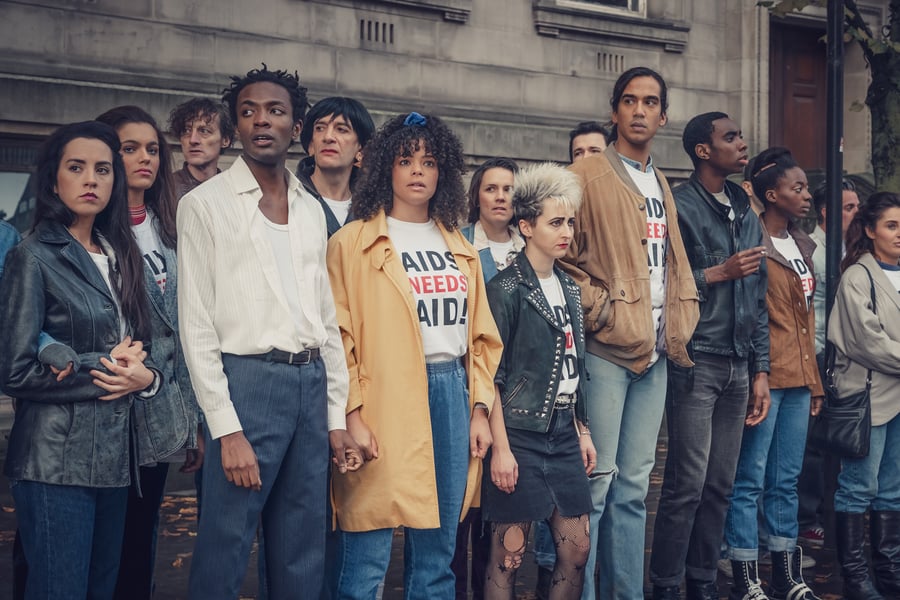Late in It’s a Sin, HBO Max’s limited series looking at the dawn of the AIDS crisis through the eyes of a group of young Londoners, a character lies on his deathbed, recalling with a smile all the parties he threw and men he slept with before he got sick. “That’s what people forget: that it was all so much fun,” he says. “Do you understand what I mean?”
This is the crucial idea behind the way It’s a Sin creator Russell T. Davies (Queer as Folk, Doctor Who) chooses to revisit this period. AIDS was a horrible blight on the gay community, exacerbated by ignorance and homophobic attitudes in England and throughout the world, and the show doesn’t shy away from any of that; it is frequently sad and rage-inducing. But unlike Davies’ last project, the relentlessly bleak (until it somehow wasn’t) near-future dystopia Years and Years, It’s a Sin has plenty of room for joy in addition to pain. That balance is crucial not only in providing a spoonful of sugar to make all the historical medicine go down, but to explain all that was lost when this plague descended.
Davies’ version of the story opens up in 1981, ostensibly with three point-of-view characters. Ritchie (Olly Alexander) is an aspiring actor whose conservative father hands him a pack of condoms as they take a ferry from their home on the Isle of Wight to where Ritchie will be attending college; Ritchie, blissfully unaware of what’s coming, tosses the rubbers aside when his dad’s not looking. Roscoe (Omari Douglas) has religious parents who keep threatening to send him back to Nigeria to have his sexuality beaten out of him. Colin (Callum Scott Howells) suffers the predatory advances of his male boss at a Saville Row menswear shop, and is only saved by the intervention of his cool, closeted co-worker Mr. Coltrane (Neil Patrick Harris in a pencil mustache and posh accent). Eventually, the three will find lodging in the same London apartment — which they nickname “the Pink Palace” — along with the story’s fourth main character, Jill (Lydia West), a classmate of Ritchie’s who deeply loves them all and becomes the first member of the group to realize the huge danger this new virus poses for them.
Each episode jumps ahead a few years from the previous one, so that the story can cover a full decade in the crisis(*). The early hours are full of life and song and possibility, but always tinged with the inescapable sense that one or more of them will get sick, and well before the triple cocktail or other treatments are available to keep them alive. The humor and light of the party scenes makes the series’ many tragedies more bearable to sit through, but those dark passages in turn lace the good times with dread. These boys have so much potential, and the party is about to end terribly for so many of them. One episode concludes with a very purposeful transition from one of the group’s celebrations to an AIDS patient’s corpse being locked into a metal coffin — a fate that could soon arrive for any of them.
(*) The finale takes place in 1991 — roughly where we last saw FX’s Pose, which offers an American (and more specifically trans) perspective on the same material, and which also opts to remember the fun whenever possible.
Davies and his collaborators here (including director Peter Hoar) at times treat HIV as the monster in a horror movie, where everyone behaves recklessly and in full denial of the danger that surrounds them. Ritchie, the most dismissive of the group, sarcastically asks in an early scene, “‘Gay cancer?’ How is a cancer gay?” But many of the series’ scariest and most maddening moments are presented in painfully spare fashion, the better to make clear that the horror came as much from how the straight establishment reacted to AIDS as from the virus itself. Getting sick is awful enough — there’s an agonizing sequence where we see how illness has essentially turned one of our heroes, barely into his twenties, into a senile old man — but these patients are also treated like lepers, locked away from the world, their possessions burned. Their friends and partners have no legal rights, so many patients wind up in custody of the homophobic families they ran away from to build new ones for themselves in London. These conditions are just brutal, portrayed in a matter-of-fact way that only emphasizes the monstrosity of it all.
And yet, even as the body count rises, Davies refuses to let go of either his clear affection for these characters or the chance to let them find pockets of happiness where they can. The fourth episode has several members of the group joining in on a public protest that starts out peaceful until the police wade in with nightsticks. It’s one of the more painful scenes to watch, but then also one of the most inspirational and happy. This unsparing yet sentimental cocktail of ingredients is one that Davies hasn’t always successfully balanced in his career, but here, it goes down perfectly. Tragedies in theory shouldn’t be much fun, but with It’s a Sin, the parts that will make you smile are at least as important, if not more so, as the ones that will make you cry.
HBO Max is releasing all five episodes of It’s a Sin on February 18th. I’ve seen all five.
From Rolling Stone US






































